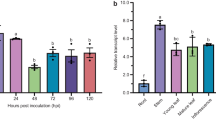Abstract
Botryosphaeria kuwatsukai is an important fungal pathogen affecting pear fruits. However, infection processes of this fungus are still unclear. This study seeks to develop the fungal transformation of B. kuwatsukai by Agrobacterium tumefaciens-mediated transformation (ATMT), assess the reliability of appropriate vectors and examine the infection processes in vitro using a GFP labeled strain of B. kuwatsukai. To establish a highly effective transformation system in B. kuwatsukai, binary vectors containing various lengths of H3 promoters and TEF promoters fused with GFP and hygromycin B resistance gene cassettes were constructed. These cassettes were integrated into the genomic DNA of B. kuwatsukai with high transformation frequency by the ATMT method. Transformants showed strong expression of GFP and hygromycin B resistance genes in cells. Furthermore, we investigated if native promoters are more suitable to govern marker genes than other general promoters used in other filamentous fungi. The results obtained herein demonstrate that the vectors constructed in this study can be utilized with high transformation rate. Microscopic examinations also reveal that fungal hyphae undergo morphological changes during the infection process resulting in biotrophic stage of infected host cells. Our results provide genetic insights to further explore the infection processes of B. kuwatsukai.










Similar content being viewed by others
References
Al-Haq MI, Seo Y, Oshita S, Kawagoe Y (2002) Disinfection effects of electrolyzed oxidizing water on suppressing fruit rot of pear caused by Botryosphaeria berengeriana. Food Res Int 35(7):657–664
Chen L, Sun GW, Wu SJ, Liu HX, Wang HK (2015) Efficient transformation and expression of gfp gene in Valsa mali var. mali. World J Microbiol Biotechnol 31(1):227–235
Chen L, Wang Q, Chen H, Sun GW, Liu HX, Wang HK (2016) Agrobacterium tumefaciens-mediated transformation of Botryosphaeria dothidea. World J Microbiol Biotechnol 32(7):106
Cormack B (1998) Green fluorescent protein as a reporter of transcription and protein localization in fungi. Curr Opin Microbiol 1(4):406–410
de Groot MJA (1998) Agrobacterium tumefaciens-mediated transformation of filamentous fungi. Nat Biotechnol 16(11):1074–1074
Frandsen RJN (2011) A guide to binary vectors and strategies for targeted genome modification in fungi using Agrobacterium tumefaciens-mediated transformation. J Microbiol Methods 87(3):247–262
Guan YQ, Chang RF, Liu GJ, Wang Y, Wu T, Han ZH, Zhang XZ (2015) Role of lenticels and microcracks on susceptibility of apple fruit to Botryosphaeria dothidea. Eur J Plant Pathol 143(2):317–330
Jones AL, Aldwinckle HS (1990) Compendium of apple and pear diseases. American Phytopathological Society, Eagan
Kabbage M, Williams B, Dickman MB (2013) Cell death control: the Interplay of apoptosis and autophagy in the pathogenicity of Sclerotinia sclerotiorum. PLoS Pathog 9(4):e1003287
Kabbage M, Yarden O, Dickman MB (2015) Pathogenic attributes of Sclerotinia sclerotiorum: switching from a biotrophic to necrotrophic lifestyle. Plant Sci 233:53–60
Kahmann R, Basse C (2001) Fungal gene expression during pathogenesis-related development and host plant colonization. Curr Opin Microbiol 4(4):374–380
Khang CH, Berruyer R, Giraldo MC et al (2010) Translocation of Magnaporthe oryzae effectors into rice cells and their subsequent cell-to-cell movement. Plant Cell 22(4):1388–1403
Kim KW, Park EW, Kim YH, Ahn KK, Kim PG, Kim KS (2001) Latency- and defense-related ultrastructural characteristics of apple fruit tissues infected with Botryosphaeria dothidea. Phytopathology 91(2):165–172
Kim KW, Park EW, Kim KS (2004) Glyoxysomal nature of microbodies complexed with lipid globules in Botryosphaeria dothidea. Phytopathology 94(9):970–977
Kim KW, Kim KR, Park EW (2005) An infection model of apple white rot based on conidial germination and appressorium formation of Botryosphaeria dothidea. Plant Pathol J 21(4):322–327
Koganezawa H, Sakuma T (1980) Fungi associated with blister canker and internal bark necrosis of apple trees. Bull Fruit Tree Res Stat C 7:83–89
Koganezawa H, Sakuma T (1984) Causal fungi of apple fruit rot. Bull Fruit Tree Res Stat C 11:49–62
Li GX, Shen YB, Gao YM, Uhm JY (2007) Study on the infection mechanism of apple ring rot disease. J Fruit Sci 24(1):16–20
Lu JP, Cao HJ, Zhang LL, Huang PY, Lin FC (2014) Systematic analysis of Zn(2)Cys(6) transcription factors required for development and pathogenicity by high-throughput gene knockout in the rice Blast fungus. PLoS Pathog 10(10):e1004432
Michielse CB, Hooykaas PJJ, van den Hondel C, Ram AFJ (2005) Agrobacterium-mediated transformation as a tool for functional genomics in fungi. Curr Genet 48(1):1–17
Mullins ED, Chen X, Romaine P, Raina R, Geiser DM, Kang S (2001) Agrobacterium-mediated transformation of Fusarium oxysporum: an efficient tool for insertional mutagenesis and gene transfer. Phytopathology 91(2):173–180
Weld RJ, Plummer KM, Carpenter MA, Ridgway HJ (2006) Approaches to functional genomics in filamentous fungi. Cell Res 16(1):31–44
Wu J, Wang ZW, Shi ZB et al (2013) The genome of the pear (Pyrus bretschneideri Rehd.). Genome Res 23(2):396–408
Xu C, Wang CS, Ju LL et al (2015) Multiple locus genealogies and phenotypic characters reappraise the causal agents of apple ring rot in China. Fungal Divers 71(1):215–231
Zhai LF, Zhang MX, Lv G, Chen XR, Jia NN, Hong N, Wang GP (2014) Biological and molecular characterization of four Botryosphaeria species isolated from pear plants showing stem wart and stem canker in China. Plant Dis 98(6):716–726
Acknowledgements
This research was supported by Natural Science Foundation of Zhejiang Province (LY15C140001). The authors thank Mr. Pudong Li, Zhejiang University, China, for his kind suggestions about the manuscript.
Author information
Authors and Affiliations
Corresponding author
Rights and permissions
About this article
Cite this article
Gu, X., Zhao, J., Wang, H. et al. ATMT transformation efficiencies with native promoters in Botryosphaeria kuwatsukai causing ring rot disease in pear. World J Microbiol Biotechnol 34, 179 (2018). https://doi.org/10.1007/s11274-018-2559-8
Received:
Accepted:
Published:
DOI: https://doi.org/10.1007/s11274-018-2559-8




